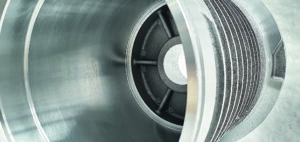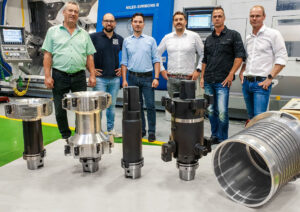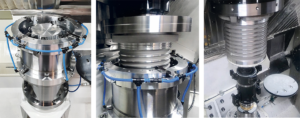Spotlight on cost-per-part in machining stator housings
When a machine tool manufacturer and a tool manufacturer known for boring and fine boring tools get together for a joint project, extraordinary results are guaranteed. NILES-SIMMONS and MAPAL have come together to develop a process that dramatically reduces the machining time of stator housings (or inner housing, cooling jacket, coolin sleeve, motor housing) for electric motors in the e‑mobility sector and also features innovative details.

Machining the stator housing includes internal machining with various sections, machining the smaller centre bore and machining the outside with its cooling ribs.
The transition from conventional combustion engines to electric drives in the automotive industry is becoming increasingly clear. NILES-SIMMONS is facing up to this change and targeting machining equipment for parts production for the e‑mobility sector with highly efficient manufacturing processes – with the aim of seamlessly following on from the successful times of crankshaft manufacture.
The majority of machines built by NILES-SIMMONS in Chemnitz are used for the machining of rotationally symmetrical workpieces. While turning plays a key role here, MAPAL as a tool manufacturer focuses primarily on cubic parts which are drilled, reamed and milled. In light of this, it’s little surprise that there had been few points of contact between the two companies in the past. That changed at the EMO 2019 trade show. At MAPAL’s stand, NILES-SIMMONS discovered an exhibit identified as a turning workpiece: a stator or motor housing for electric motors. By then, MAPAL had established fine boring tools for machining parts on milling centres as a highly efficient and ultra-precise process in the industry.
A BENEFICIAL BLEND OF TURNING AND BORING OR FINE BORING
Soon, both sides had the impression that a combination of turning, boring and fine boring could take machining this key component for e‑mobility to a new level. Following the trade show, they set up a joint development project. NILES-SIMMONS rebuilt a machine for the project and MAPAL supplied tools for pre‑, semi- and fine machining.
Pot-shaped parts like stator housings are a frequently used design for electric motors in the automotive industry. The thin-walled aluminium housing features ribs on the outside for the cooling circuit and is installed in the larger motor housing. “Here, we have a rotational workpiece with a rear-side imbalance that can be turned, but, due to the high level of diameter accuracy and the shape and position tolerance required by the market, must be bored and fine bored,” says MAPAL’s Area Sales Manager André Ranke, describing the starting point for the partnership. A customer workpiece was not used for the tests carried out at NILES-SIMMONS with MAPAL technicians as part of the project. Instead, MAPAL designed a dummy that featured all production-ready requirements. The inner diameters vary between 220 mm and 231 mm, and the outer diameters
between 250 mm and 260 mm. Inner and outer fit tolerances in the IT6 range and cylindrical forms between 20 and 30 μm are required. The concentricity between the different diameters is limited in some cases to 0.05 mm.

Projectteam (v.l.): Sales Manager Thomas Lötzsch, Development Engineer Technologie Christian Winkler, Project Manager Daniel Pilz (all NILES-SIMMONS), Area Sales Manager André Ranke, Technical Advisor Axel Schwarze und Application Engineer Heiko Süß (all MAPAL). In the foreground, the MAPAL internal machining tools for (from left) pre-roughing, roughing, machining the center bore and finishing, as well as the workpiece.
ALL OF THE TOOLS ARE ALREADY IN THE MACHINE
For the development project, NILES-SIMMONS selected a DZS 315-type pick-up lathe from NSH subsidiary RASOMA, also based in Saxony. The machine has a modular design and can therefore be configured precisely to suit the relevant machining process. The test set-up featured a vertical workpiece spindle at the top, a workpiece spindle underneath, a tool console and a tool revolver. Generally speaking, additional machining
units can be built into the machine, meaning all necessary tools can be housed in the machine, reducing set-up and non-productive time. The upper spindle picks up the workpiece and moves it to the stations one after another in a single clamping setup with the lathe slide.
There are advantages to vertical machining. One of these is the space-saving interlinked setup of individual machining units, optimum transport of chips and processing agents, and a compact design with a small installation area, including a pick-up system.
“The pick-up is a standard solution for turning, as it is already widely used today for comparable parts. This loading solution is perfectly designed for automated mass production of stator housings,” says Thomas Lötzsch, Sales Manager at NILES-SIMMONS.
The key benefit of the newly developed process is the potential boost in productivity. From the outset, part production time has already been cut by 50 percent in the combined turning and boring process compared to the conventional turning process. Daniel Pilz, who managed the project at NILES-SIMMONS, describes how time is saved in each individual step, which, as the case may be, may involve the turning of the workpiece, of the tool or of both.

left + center: The workpiece is clamped to the upper pindle and moved to the machining stations one after another in one clamping setup.; right: The first step is roughing the inside of the housing.
NEW WAYS TO USE TRIED-AND-TESTED TOOLS
The first station turns the process previously used by MAPAL on its head. Instead of roughing the part with a rotating tool, the tool sits still in the machine, and it’s the workpiece coming from above that turns. As MAPAL’s tool is equipped with four blades, unlike a conventional turning tool, only around a quarter of the time is needed to completely pre-rough the various inner diameters on the part.
In the second machining step, a bell-shaped tool developed by NILES-SIMMONS is used for the outer contour, while a MAPAL ISO boring tool is used for semi-finishing the inner diameter. The inside and outside of the workpiece are machined at the same time. “What’s special is that a stationary, vertical external machining tool is placed to the spindle housing. The spindle drives the internal machining tool,” says Daniel Pilz, describing the setup. The workpiece dips into the annular gap formed by these two tools. All diameters are produced with one single feed movement – for this specific part, this amounts to three inner and three outer diameters. Four blades are used for each diameter. “As well as being able to machine the inside and outside simultaneously, altogether we take just an eighth of the time we would need for conventional turning,” says Pilz. Other benefits include the following:
• Due to the counteracting cutting forces of the internal and external machining, a lower torque must be maintained on the workpiece clamping device
• Vibrations in the thin-walled part during machining are absorbed by the simultaneous cutting action of the inserts on the inside and outside.
In this test, simultaneous internal and external machining took place with a cutting speed of 700 m/min. Machining using the sandwich method with the workpiece in the middle ensures that the part is stabilised during machining, as the inserts are cutting on both sides at the same time and thus guiding the part. Complex clamping technology with vibration dampening is not required, which has a noticeable impact on costs. While industry already uses MAPAL’s tool on horizontal machining centres for the internal machining of stator housings, the bell-shaped external tool from NILES-SIMMONS was newly developed and a patent was filed for the innovative process.
The subsequent fine machining process uses an already tried-and-tested MAPAL fine boring tool with guide pads, which is ultimately used to fully finish the centre bore for the stator bearing, including all stages. MAPAL produces the fine boring tool used in various designs. A welded design with blades and guide pads made from PCD was used for the tests in Chemnitz. The diameter can be adjusted in the μm range.

left: The semi-finishing tool for inner machining is clamped in the lower spindle. It is surrounded by the bell-shaped outer tool, which is securely mounted; center: In simultaneous machining, the workpiece is moved into the annular gap between the outer tool and the inner tool from above. Plenty of cooling lubricant is used for machining.; right: Fine machining of all inner diameters is done with a fine boring tool.
STATOR HOUSING ARE THE NEW CRANKSHAFTS
NILES-SIMMONS expects the manufacturing of stator housings or cooling jackets to become as important to electric mobility as crankshafts were to combustion engines in the past. The expected quantities, cycle times and costs are in a comparable range. “Enquiries for these parts amount to 250,000 parts per year,” says COO Klaus Kräher. By 2030, there may be demand for as many as 20 to 50 million parts worldwide. “A 50 percent time saving is a
huge statement, especially as there is definitely more potential in our new process,” says Kräher.
In addition to the successfully implemented vertical concept, NILES-SIMMONS is also investigating the possibility of refitting existing horizontal machines. The Chemnitz-based company has over 300 turn-broaching and crankshaft milling machines currently in use in car manufacturers’ crankshaft production lines worldwide. Both the innovative process and MAPAL’s tools can also be integrated into a horizontal version of the concept.
MAPAL also offers the possibility of using additively-manufactured tools in which weight savings are not the sole focus and coolant outlets can be geared even more specifically towards the cutting edge.
Apart from the machining of stator housings, the process can also be used for other workpieces from a wide range of sectors, such as cooling elements for hybrid engines, pipe and flange couplings for the oil and gas industry, bearing and housing components for general machining, and workpieces for the plastics industry. This makes this process relevant for a very wide range of different workpieces with tube- and pot-shaped
geometry requiring tolerances less than or equal to IT6 and with ultra-precise shape and position tolerance.

